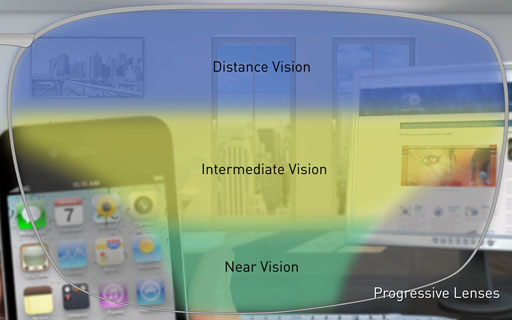Progressive Lenses

The only downside is that it takes a little while to get used to progressive lenses. Changes in vision occur towards the lenses edges result in altering the peripheral vision slightly. For some people the change is a little difficult.
Types of Progressive Lenses
1. Standard Progressive Lenses
If you are looking for an alternative to bifocals or trifocals, standard progressive lenses will work for most people, and fit most budgets. Although the price of standard progressive lenses is higher than regular flat-top bifocal or trifocal lenses, they are still quite affordable. Depending on brand name, standard progressive lenses range in price from $175-250 for the base lenses.Standard progressive lenses will give you a fairly wide reading area, but require a certain sized frame to allow enough vertical height to give a smooth transition from distance vision down to reading. If too short a frame is chosen, the most useful reading power may be cut off when the lenses are manufactured.
2. Short Corridor Progressive Lenses
Gone are the days of having to sacrifice fashion for progressive lenses. Slightly more expensive than standard progressive lenses, short corridor progressive lenses are designed to fit into smaller frames. Because of their size, however, it takes a skilled optician to fit them properly. You may have difficulty adapting to short corridor progressive lenses because the "corridor" for reading vision is not very wide, causing distortion when you look outside of the corridor. If you look down to read, make sure you look straight ahead, not out to the sides. These specialty lenses range from $250-350.3. Computer Progressive Lenses
Computer progressive lenses, also known as "office lenses" or "near variable focus lenses", are designed for use in an office and are intended to provide clear vision at around 16 inches to 6 feet. Computer progressive lenses are great for people needing clear vision at intermediate and near distances such as painters, artists, dentists, librarians, hair dressers, mechanics, draftsmen, and editors. If you use a computer more than 4 hours per day, these lenses are ideal and help alleviate visual fatigue, or computer vision syndrome. These lenses also allow for better posture, making it easier to hold your head in a more natural position. Computer progressive lenses generally range in price from $150-250.4. Premium Progressive Lenses
Premium progressive lenses are often referred to as "free-form design" or "wave-front technology." Premium progressive lenses provide a much wider, distortion-free reading area. Vision is often clearer, as these lenses are usually 100% digitally surfaced or ground. This customizes the prescription for you as well as the frame you desire. Instead of compacting a lens design, as with a short corridor progressive, the lens is totally customized so that all ranges of power fit nicely into any frame. As expected, these lenses are more expensive than standard or entry level progressive lenses. These lenses range from $400-800.Comparing Bifocals, Trifocals, and Progressive Lenses
Bifocal lenses serve a dual purpose effectively. However, there are few major disadvantages such as switching between near and far vision can be abrupt and there is no intermediate vision line available.
To a little extent, trifocal lenses help overcome the absence of intermediate region in bifocals. However, they are very difficult to get adjusted to because of the distinct lines that separate multiple levels of vision in each field.
Progressive lenses on the other hand offer superior vision and comfort when compared to bifocals and trifocals as they come closest to imitating natural vision of human eyes. As compared to bifocals and trifocals, progressive lenses offer multi focal vision correction that offer smooth and gradual focus from far to near vision. The biggest advantage of progressive lenses is that they eliminate the struggle of vision adjustment or abrupt jumps in images and offer all three fields of vision without any visible lines.
However, as said earlier, progressive lenses may take a while to get used to. Especially, if you are not used to the gradient lens. Also, typically progressive lenses work best in medium to large frames. If the frame length is smaller, then it may limit the reading portion of the lens.
